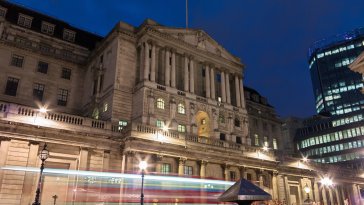
UK reaction: Quarterly pace for now, but risks are to the downside
- 19 September 2024 (5 min read)
The Bank showed it was committed to a gradual path for easing today, voting to maintain Bank Rate at 5%, as both we, and the consensus, had expected. Eight of the nine members voted for no change, while Dhingra, voted for a further cut to 4.75% - Ramsden was also expected to maintain his vote, so the split was slightly more hawkish than the consensus had expected. But we doubt this was a signal, with the message from today’s meeting broadly being “nothing to see here”. Indeed, the MPC noted that there hadn’t been sufficient news on the UK since the August meeting to cut today. Separately, the MPC set the path for QT over the coming 12 months at £100bn, unchanged from the current pace. Note, though, that this means the pace of active sales will fall to around £13bn, given the pace of passive QT will rise to £87bn over the coming 12 months, from around £40bn.
We think a further 25p cut in November is in keeping with recent messaging. The MPC continued to highlight that within the group that voted for no change “there was a range of views” suggesting the vote remained close for those that changed their vote from August – namely Bailey, Ramsden, Lombardelli and Breeden – and that “a gradual approach to removing policy restraint seem appropriate”.
Looking ahead, and in keeping with the Bank’s recent three scenario characterisation, we think the skew of risks is tilted towards a faster pace of tightening. Admittedly, wage growth and services CPI inflation both remain above 5%, higher than in the Eurozone and the US. But pretty much every forward-looking indicator points to a more material slowdown over the coming 12 months, while households’ inflation expectations are now back broadly at the levels seen prior to the inflationary shock. In addition, CPI inflation has come in below the BoE’s forecasts in July and August, leading the Bank to revise down its end-year inflation expectation to 2.5%, from 2.75%. And the Committee noted the fall in global oil prices on the back of weaker demand and the 1% appreciation in the sterling effective exchange rate since the last meeting – it had been expected to remain broadly flat in the latest MPR – both of which are positive for the disinflationary outlook.
The main risk, though, stems from the October 30th Budget – just a week before the Bank’s November meeting. This looks likely to increase pressure on the Bank to quicken the pace of the cutting cycle if fiscal policy is tightened by more than currently laid out by the previous government. This looks likely to us, given the recent signals from the new government, including the mention of the £22bn black hole in the public finances and the hints at potential further tax increases. If the government is more stringent on fiscal policy, we think the Bank will be forced to increase the pace of the cutting cycle to offset the hit on both households’ and businesses’ finances. For now, we are sticking with our forecast for just one further cut this year to 4.75%, but a December cut is a risk.
Disclaimer
This document is for informational purposes only and does not constitute investment research or financial analysis relating to transactions in financial instruments as per MIF Directive (2014/65/EU), nor does it constitute on the part of AXA Investment Managers or its affiliated companies an offer to buy or sell any investments, products or services, and should not be considered as solicitation or investment, legal or tax advice, a recommendation for an investment strategy or a personalized recommendation to buy or sell securities.
It has been established on the basis of data, projections, forecasts, anticipations and hypothesis which are subjective. Its analysis and conclusions are the expression of an opinion, based on available data at a specific date.
All information in this document is established on data made public by official providers of economic and market statistics. AXA Investment Managers disclaims any and all liability relating to a decision based on or for reliance on this document. All exhibits included in this document, unless stated otherwise, are as of the publication date of this document.
Furthermore, due to the subjective nature of these opinions and analysis, these data, projections, forecasts, anticipations, hypothesis, etc. are not necessary used or followed by AXA IM’s portfolio management teams or its affiliates, who may act based on their own opinions. Any reproduction of this information, in whole or in part is, unless otherwise authorised by AXA IM, prohibited.
Issued in the UK by AXA Investment Managers UK Limited, which is authorised and regulated by the Financial Conduct Authority in the UK. Registered in England and Wales No: 01431068. Registered Office: 22 Bishopsgate London EC2N 4BQ
In other jurisdictions, this document is issued by AXA Investment Managers SA’s affiliates in those countries.
© AXA Investment Managers 2024. All rights reserved





